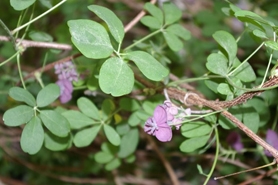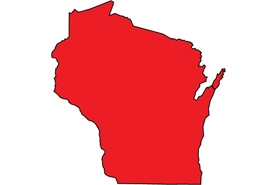Fiveleaf akebia/Chocolate vine
(Akebia quinata)
A deciduous vine that mainly reproduces vegetatively. Leaves are palmately compound with five round-obovate leaflets. Vines are green when young, turning brown as they age. Stems have small round lenticels. Plants are evergreen in warmer climates.
Other names for this plant include:
- Common names: Fiveleaf
- Scientific names: Akebia micrantha; Rajania quinata
Classification in Wisconsin: Prohibited
- Ecological Threat
-
- It invades many types of habitats including forests, wetlands and disturbed areas.
- Tolerates a wide range of conditions from full sun to full shade and drought tolerance.
- Decreases tree and shrub regeneration and establishment by shading and smothering.
- Vigorously climbs trees and forms a dense groundcover layer up to 1 foot deep.
- It can grow up to 40 feet per year.
- Identification
-
Leaves: Palmately compound with usually five oval leaflets, 1.5-3 inches long with smooth edges. Dark green in color above and glaucous below. Prominent mid-vein with a notched tip.
Flowers: Fragrant flowers faintly resemble chocolate. Flowers are small, purple/violet in color and bloom in early to mid-spring.
Fruits & seeds: Purple sausage-shaped fruit pods are rarely produced and are 2-4 inches long with deep sutures on one edge. Pods have inner white pulp that encases 100-200 tiny black seeds.
Roots: Rooting also occurs where stem nodes come into contact with the soil.
Similar species: Virginia creeper (Parthenocissus quinquefolia; native) also has a leaf arrangement of five but with coarsely toothed edges.
- Distribution
-
Currently, there are no reports of five-leaf akebia in Wisconsin. Have you seen it? Please send us a report.
- Control
- Mechanical:
- For small or scattered infestations, manual and mechanical methods may suffice. Cutting can be done at any time of year. Repeated cutting is needed to stimulate growth and eventually exhaust root reserves. Cutting plants back and layering thick cardboard with several inches of wood chips may control smaller groundcover populations.
- For large infestations spanning extensive areas of ground, a combination of manual, mechanical, and chemical control methods may be more practical and effective. A foliar herbicide may be the best choice when considering minimal soil disturbances. For vines climbing up trees or buildings, a combination of cutting followed by applying concentrated systemic herbicide to rooted, living cut surfaces is likely to be the most effective approach.
- Foliar spray of systemic herbicides 2-5% triclopyr (Garlon® 3A and Garlon® 4) and 2-4% solution of glyphosate should be applied in summer to fall.
- Herbicides are most effective when plants are fully leafed-out to absorb and translocate chemicals to the roots.
- Always follow label limits and precautions.
- Resources
- Sources for content:
- USDA, ARS, National Genetic Resources Program. Germplasm Resources Information Network - (GRIN) [Online Database]. National Germplasm Resources Laboratory.
- Center for Invasive Species and Ecosystem Health; Invasive.org
- Plant Conservation Alliance, Alien Plant Working Group


